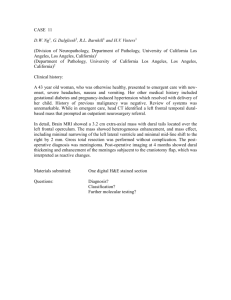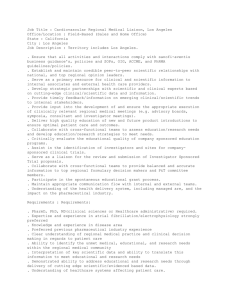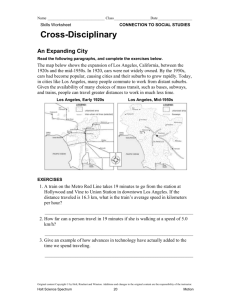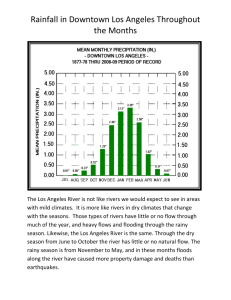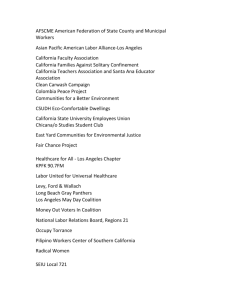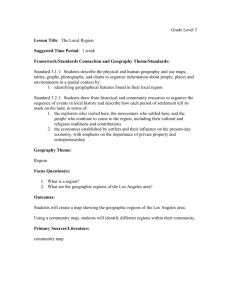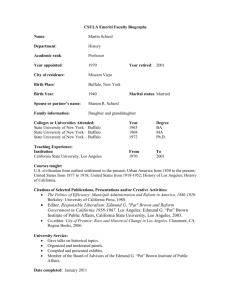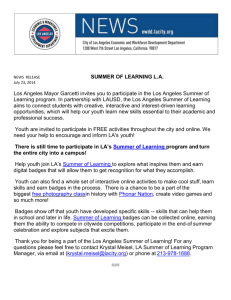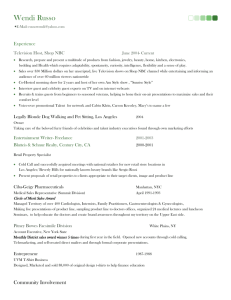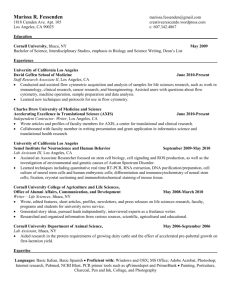SurveyLA: Boyle Heights Historic Resources & Parker Center
advertisement
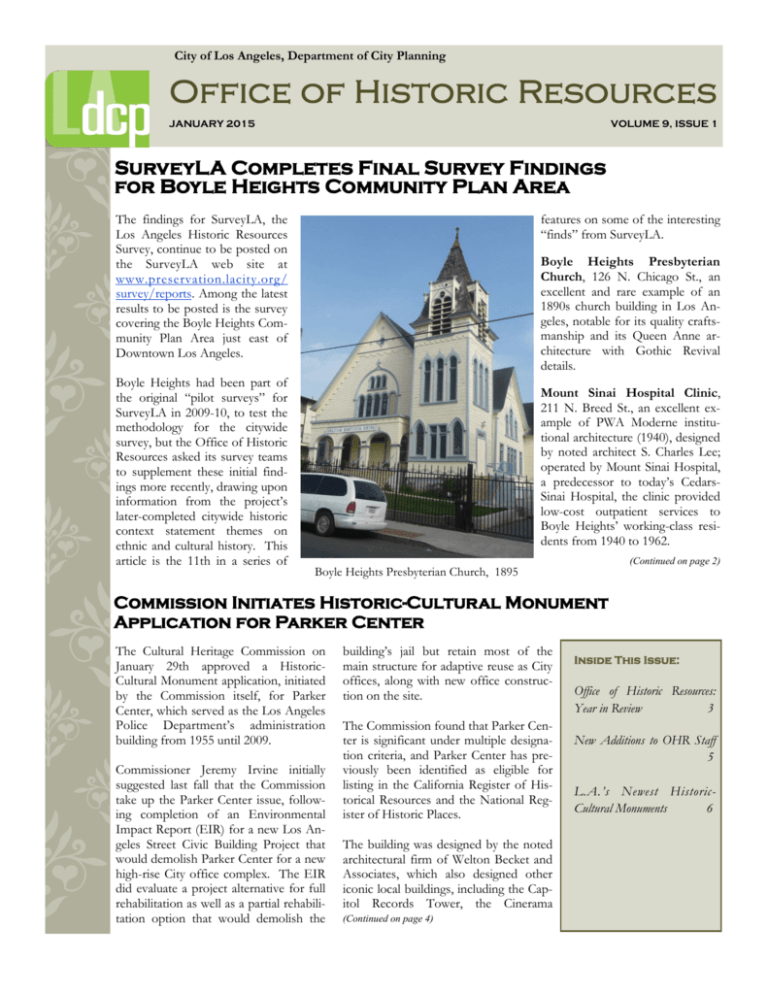
City of Los Angeles, Department of City Planning Office of Historic Resources JANUARY 2015 VOLUME 9, ISSUE 1 SurveyLA Completes Final Survey Findings for Boyle Heights Community Plan Area The findings for SurveyLA, the Los Angeles Historic Resources Survey, continue to be posted on the SurveyLA web site at www.preservation.lacity.org/ survey/reports. Among the latest results to be posted is the survey covering the Boyle Heights Community Plan Area just east of Downtown Los Angeles. Boyle Heights had been part of the original “pilot surveys” for SurveyLA in 2009-10, to test the methodology for the citywide survey, but the Office of Historic Resources asked its survey teams to supplement these initial findings more recently, drawing upon information from the project’s later-completed citywide historic context statement themes on ethnic and cultural history. This article is the 11th in a series of features on some of the interesting “finds” from SurveyLA. Boyle Heights Presbyterian Church, 126 N. Chicago St., an excellent and rare example of an 1890s church building in Los Angeles, notable for its quality craftsmanship and its Queen Anne architecture with Gothic Revival details. Mount Sinai Hospital Clinic, 211 N. Breed St., an excellent example of PWA Moderne institutional architecture (1940), designed by noted architect S. Charles Lee; operated by Mount Sinai Hospital, a predecessor to today’s CedarsSinai Hospital, the clinic provided low-cost outpatient services to Boyle Heights’ working-class residents from 1940 to 1962. (Continued on page 2) Boyle Heights Presbyterian Church, 1895 Commission Initiates Historic-Cultural Monument Application for Parker Center The Cultural Heritage Commission on January 29th approved a HistoricCultural Monument application, initiated by the Commission itself, for Parker Center, which served as the Los Angeles Police Department’s administration building from 1955 until 2009. Commissioner Jeremy Irvine initially suggested last fall that the Commission take up the Parker Center issue, following completion of an Environmental Impact Report (EIR) for a new Los Angeles Street Civic Building Project that would demolish Parker Center for a new high-rise City office complex. The EIR did evaluate a project alternative for full rehabilitation as well as a partial rehabilitation option that would demolish the building’s jail but retain most of the main structure for adaptive reuse as City offices, along with new office construction on the site. The Commission found that Parker Center is significant under multiple designation criteria, and Parker Center has previously been identified as eligible for listing in the California Register of Historical Resources and the National Register of Historic Places. The building was designed by the noted architectural firm of Welton Becket and Associates, which also designed other iconic local buildings, including the Capitol Records Tower, the Cinerama (Continued on page 4) Inside This Issue: Office of Historic Resources: Year in Review 3 New Additions to OHR Staff 5 L.A.’s Newest HistoricCultural Monuments 6 Page 2 VOLUME 9, ISSUE 1 SurveyLA Boyle Heights Findings (Continued from page 1) Mount Carmel Missionary Baptist Church, 3064 E. 1st St., a 1936 Spanish Colonial Revival church that was one of the few institutional buildings serving Boyle Heights’ African American community. Otomi Café, 2506 E. 1st St., an 1890 commercial vernacular building that has been the long-term location, since 1956, of what is believed to be the last remaining Japanese restaurant in Boyle Heights, which was once a center of the Japanese-American community. Los Angeles Japanese Baptist Church, 2923 E. 2nd St., a 1926 Art Deco-influenced church that is a rare remaining example of institutional development associated with the Japanese American community that resided in Boyle Heights. Rafu Chuo Gakuen Japanese Language School, 204 N. Saratoga St., which has provided instruction in Japanese language, conversation and culture since the 1930s and is one of the few secular Boyle Heights Japanese American institutions to remain in operation. Kiu Sing Chan Residence, 2309 E. 3rd St., an 1898 Queen Anne home that is significant as the residence of Kiu Sing Chan, one of the few Chinese Americans to own property in Boyle Heights during a period of antiimmigration sentiment and discrimination against Chinese immigrants. A court interpreter by trade, Chan became the first Methodist minister of Chinese descent in the United States. Los Angeles Sanitorium/Jewish Orphans Home, 2033 E. 4th St., constructed in 1906 as a Santorium and natural health resort opposite Hollenbeck Park, operated by Dr. H. Russell Burner, a medical professor who gained notoriety for popularizing a radioactive elixir known as “radium milk.” The property re-opened around 1910 as the Jewish Orphans’ Home, to serve the area’s rapid increase in Jewish immigrants from Russia and Eastern Europe. Houston Street Shul/Congregation B’nai B’rith, a 1936 Vernacular/ Neoclassical structure that is a rare remaining example of institutional development associated with the Jewish community that resided in Boyle Heights. Vladeck Center, 126 N. St. Louis, a 1941 PWA Moderne building that served as a meeting venue for local Jewish labor organizations and was considered the secular heart of Jewish life in Boyle Heights between 1941 and 1960. Mexican Mission Church, 1524 E. Pleasant Ave., a Mission Revival church established in 1930 by noted evangelist and media celebrity Aimee Semple McPherson, to attract the area’s sizable Mexican American community to the Foursquare Church. The church has remained in continuous operation ever since and continues to offer Spanish language services. Casa del Mexicano, 2900 Calle Pedro Infante, was founded by the Mexican Consulate in 1951 as a cultural center and performance venue for the area’s Mexican American population St. Mary’s Catholic Church, 2124 E. 4th St., a 1925 Romanesque Revival church, the work of noted ecclesiastical architect Thomas Franklin Power, and one of the first churches in the area to offer Spanish language services. David Paulson Memorial Hall, 1815 E. Bridge St., a 1932 Art Deco building named for a prominent physician and philanthropist in the Adventist church, which served as the chapel for White Memorial Hospital. Forsythe Memorial School/Evergreen Hostel, 506 N. Evergreen Ave., a 1914 Mediterranean Revival structure that was (Continued on page 3) Page 3 VOLUME 9, ISSUE 1 SurveyLA Boyle Heights Findings Russian Baptist Church, 129 S. Gless St., a 1919 Mission Revival church that is a rare remaining example of institutional development associated with the Russian community that resided in Boyle Heights. (Continued from page 2) one of several boarding schools operated by the Presbyterian Church with an assimilation-based curriculum, to provide education for girls of Mexican descent in American customs, traditions, and cultural values. The property was re-opened as the Evergreen Hostel in 1945 and provided shortterm accommodations to Japanese American families returning to Boyle Heights from their internment during World War II. 624 and 628 S. Evergreen Avenue, Craftsman homes from 1912 and 1913 that were the residences of former war hero Eugene A. Obregon (624) and Councilmember and Congressman Edward Roybal (628). Obregon was a Marine of Mexican American descent who was posthumously award the Congressional Medal of Honor for shielding a comrade in battle during the Korean War in 1950. Roybal in 1949 became the first Latino elected to the Los Angeles City Council in over 60 years and later served for 30 years in Congress. Mount Pleasant Residential Historic District, a neighborhood roughly bounded by Cesar Chavez Ave., Pleasant Ave., and Boyle Avenue, which is an excellent example of a late 19th century neighborhood, originally subdivided in 1875, developed adjacent to an early streetcar line connecting Boyle Heights with Downtown Los Angeles. Estrada Courts (multiple addresses), constructed beginning in 1942, was one of the earliest public housing projects in Los Angeles, designed by noted architects Robert Alexander, Winchton Risley, David Witmer, and Loyall Watson. It is also significant for its intact concentration of approximately 50 murals, most of which were painted between 1973 and 1980 by several notable Chicano artists. Office of Historic Resources: Year in Review Every year, the Office of Historic Resources manages many different aspects of Los Angeles’ cultural resources. From processing Historic-Cultural Monument applications to conducting field surveys for historic resources, the OHR is never idle. Last year, much was accomplished in protecting the City’s historic resources through designation, project review and education, affecting all types of cultural resources in the city. The following is a quick recap of some of our key milestones: 25 Historic-Cultural Monuments taken under consideration 16 Historic-Cultural Monuments were designated, bringing the total number to 1076 monuments 64 Mills Act contracts were recorded, bringing the total number to 771 contracts. This year there were: (Continued on page 5) What Is SurveyLA? SURVEYLA: THE LOS ANGELES HISTORIC RESOURCES SURVEY PROJECT is the first-ever comprehensive inventory of our city’s historic resources. The survey findings will have a multiplicity of benefits and uses: it will help direct future growth, shape the revision of Los Angeles’ 35 Community Plans, streamline environmental review processes, provide opportunities for public education, assist in disaster planning, and spur heritage tourism and the marketing of historic neighborhoods and properties. The J. Paul Getty Trust and the City of Los Angeles have entered into a grant agreement for SurveyLA under which the Getty has committed to providing up to $2.5 million to the project, subject to matching requirements by the City. Field surveys and evaluations will occur through 2016. The Getty Conservation Institute (GCI) is also providing technical and advisory support for SurveyLA. For more information visit the SurveyLA website, www.SurveyLA.org. Page 4 Volume 9, Issue 1 Commission Initiates Historic-Cultural Monument Application for Parker Center stand how the city has evolved. Furthermore, Commissioner Gail Kennard noted, the legacy of Parker Center also includes the emergence of a police captain, Tom Bradley, who later became Los Angeles’ first African-American Mayor, as well as numerous other diverse leaders of the LAPD, including Bernard Parks, who rose to become both Chief of Police and a City Councilmember. (Continued from page 1) Parker Center façade rhythm Dome, the Santa Monica Civic Auditorium, and the Music Center of Los Angeles County. When it opened in 1955, the Police Facilities Building (renamed after Chief William Parker in 1966) established the LAPD as a leader in advanced, modern policing techniques, incorporating new technology and communications facilities and a state-of-the-art crime lab. Parker Center also helps tell the story of the history of the LAPD, and the history of Los Angeles. While some of the LAPD’s policing techniques from the era of Parker Center remain controversial, and while Parker Center remains a symbol of strained relations with many Los Angeles communities, the Cultural Heritage Commissioners felt that this very mixed legacy provides an important argument for its designation and preservation – so that Los Angeles communities can under Parker Center Exterior With the Commission’s approval of the nomination, the matter goes on to the City Council, which has until the end of April to consider the proposed designation. Lobby mosaic wall Volume 9, Issue 1 Page 5 Nels Youngborg and Renata Dragland Join OHR Staff The OHR is very pleased to welcome Nels Youngborg and Renata Dragland to its staff, as new planners. Nels Youngborg has a B.A. from the University of Rochester, a Graduate Certificate in Historic Preservation from the University of Texas, San Antonio, and completing an M.S. in Historic Preservation from the University of Pennsylvania. He has worked as an intern, a Student-Professional Worker, and an Emergency Appointment Planning Assistant for the OHR since June 2013, helping to manage the City’s Mills Act Historical Property Contract program, working on social media initiatives for SurveyLA, and conducting project reviews for compliance with historic preservation standards. Nels will be assuming significant responsibility for the OHR’s Mills Act program and Cultural Heritage Commission staff recommendations. Renata Dragland is joining the OHR’s Historic Preservation Overlay Zone (HPOZ) Unit, where she will oversee the management of several Los Angeles historic districts. She has attained a B.S. in Architecture and Urban Design from the Universidade Federal do Paraná in Curitiba, Brazil and an M.S. in Urban Planning from Columbia University’s Graduate School of Architecture, Planning and Preservation, during which she received the American Institute of Certified Planners’ Outstanding Planning Student Award for 2010. Since graduation, she has worked as a planner for the New York City Department of Transportation and the Planning Division for the City of Norwalk, CA. Office of Historic Resources: Year in Review (Continued from page 3) 54 Single-family Residences 7 Multi-family Residences SurveyLA published the ground-breaking LGBT Historic Context Statement 3 Commercial Properties Organized the first annual Mills Act Workshop Hosted over 200 attendees in October at the Los Angeles Historic Neighborhoods Conference, organized with the Los Angeles Conserrvancy SurveyLA published results for seven Community Plan Areas Office of Historic Resources Department of City Planning 200 N. Spring Street, Room 559 Los Angeles, CA 90012 (213) 978-1200 Four new staff members were hired as either part– or full-time employees The OHR moved from room 620 to 559 in City Hall Los Angeles City Hall Office of Historic Resources Staff: Ken Bernstein, Manager Janet Hansen, Deputy Manager Lambert Giessinger, Preservation Architect Edgar Garcia, Preservation Planner Nels Youngborg, Planning Assistant Many thanks to all of the OHR’s partners who made 2014 such a success. Happy New Year, Angelenos! HPOZ Unit: Staff City Hall, Room 601 Michelle Levy, City Planner Renata Dragland, City Planning Associate Shannon Ryan, City Planning Associate Steven Wechsler, Planning Associate Kimberly Henry, Planning Assistant Tim Rosenstein, Student Professional Worker Blair Smith, Student Professional Worker Page 6 Volume 9, Issue 1 L.A.’s Newest Historic-Cultural Monuments The Cultural Heritage Commission and City Council have designated seven new Historic-Cultural Monuments (HCMs) between October 2014 and January 2015. Los Angeles’ newest Monuments include the following: HCM #1076, Presburger House (4255 Agnes Ave.) This one-story, MidCentury Modern style house built in 1945 is an excellent example of Rudolph Schindler’s design philosophy and construction methods. Located in Studio City, it is a rare remaining example of a “Schindler Frame,” house with a low, one-story elevation, floors that extend into the garden, full height glass walls, and a shed roof with clerestory windows. HCM #1078, John L. Matheson/Church of Latter Day Saints California Mission (2067 Hobart Blvd.) Located in the preeminent Harvard Heights neighborhood, this 1909 building is an excellent example of Tudor Revival architecture. This grand, single-family residence was designed by notable architect Frederick Louis Roehrig, a master of Craftsman architecture. The residence’s façade is arranged asymmetrically and features a two-story masonry tower. Originally built for John L. Matheson, a successful businessman, in 1929 it was sold to the Mormon Church, who owned the property until 1954. The Church converted the home to a duplex and established the building as their California Mission, which housed missionaries traveling to the region. HCM #1077, North Hollywood Masonic Temple (5122 Tujunga Ave.) Built in 1949, the North Hollywood Masonic Temple is a stunning and rare example of Mayan Revival style architecture in Los Angeles. The temple is the work of Robert Stacy-Judd, who is well known for his Mayan Revival style works in England and the United States. Character-defining features include its frontfacing, central tower, which features a faux-corbeled arch and geometric balustrade at the entrance and is topped by a stepped pyramid shape. A frieze of glazed blue tiles engraved with a repetitive Mayan hieroglyph wraps around the front and side facades. Although the exterior facade has remained intact, the interior has been significantly altered, and therefore only the façade has been designated. HCM #1079, Playa del Rey Stone Pillars (179-200 Culver Blvd.) These two stone pillars were constructed in 1925 as wayfinding elements for the “Wonder House of Stone,” also known as the Ernest Flagg Stone House, a stone construction model house built for the Surfridge development in Playa del Rey by Dickinson & Gillespie. The house utilized New York architect Ernest Flagg’s construction plans for stone houses, which were popular throughout the country for their economy and efficiency. Although the model home was eventually demolished, these unique pillars bear Flagg’s influence and were constructed with the same materials as the house. The pillars consist of a cast-stone base, stone-clad column, cap and chalice and have had minimal alterations over the years. They stand as one of the last remnants of Playa Del Rey’s earliest phase of development in the 1920s and reflect a popular construction method of the era. HCM #1080, Appel House (5730 Spring Oak Dr.) This one-story, single -family residence located in Hollywood’s Bronson Canyon, is an excellent example of the French Provincial style designed by Lawrence Bowman Clapp in 1938. The residence features an irregular floor plan and steep cross-hipped roofs with an iron balustrade along the peak. The façade is dominated by two rounded bays with casement lattice windows and decorative frieze runs along the top of the bays. Character defining interior features consist of pocket doors, decorative cabinetry, and parquet wood floors. Clapp designed the residence for David Appel, president of the Pacific Construction Finance Company, a multi-service building company which operated from the 1920s to 1960s.
